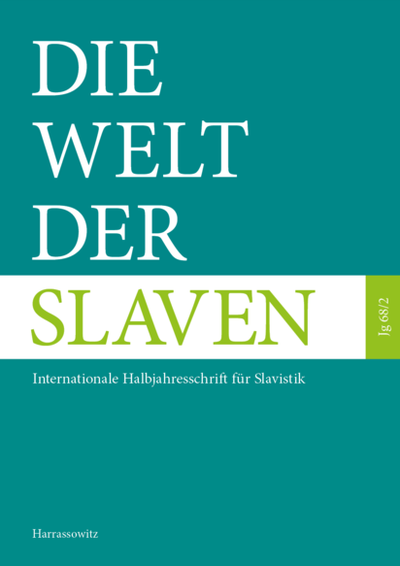The role of noun termination in grammatical gender assignment in Polish
A psycholinguistic study
DOI:
https://doi.org/10.13173/WS.68.2.291Schlagwörter:
grammatical gender, gender assignment, gender access, gender cues, PolishAbstract
Previous research has shown that speakers of a variety of languages benefit from formal gender cues, e.g. word ending, when assigning grammatical gender to nouns. However, the extent to which Polish speakers compute gender based on such cues has not yet been examined. Therefore, the goal of this study was to investigate the role of noun termination in gender assignment in Polish on psycholinguistic grounds. The paper reports on a timed Gender Decision Task which was carried out with 24 adult native speakers of Polish. Participants responded significantly faster to gender-transparent than to gender-opaque feminine nouns. However, no effect of noun termination was observed for masculine and neuter nouns. The results provide psycholinguistic evidence that the ending -a constitutes the strongest gender cue that Polish speakers can depend on when assigning gender to nouns, arguably because it is the only noun ending that shows high availability and reliability in parallel.
Literaturhinweise
Bobb, Susan & Kroll, Judith F. & Jackson, Carrie N. 2015. Lexical constraints in second language learning: Evidence on grammatical gender in German. Bilingualism: Language and Cognition 18(3). 502–523.
Caffarra, Sendy & Janssen, Niels & Barber, Horacio A. 2014. Two sides of gender: ERP evidence for the presence of two routes during gender agreement processing. Neuropsychologia 63, 124–134.
Caffarra, Sendy & Barber, Horacio A. & Molinaro, Nicola & Carreiras, Manuel. 2017. When the end matters: Influence of gender cues during agreement computation in bilinguals. Language, Cognition and Neuroscience 32(9). 1069–1085.
Comrie, Bernard. 1999. Grammatical gender systems: A linguist’s assessment. Journal of Psycholinguistic Research 28(5). 457–466.
Corbett, Greville G. 1991. Gender. Cambridge: Cambridge University Press.
De Martino, Maria & Bracco, Giulia & Laudanna, Alessandro. 2011. The activation of grammatical gender information in processing Italian nouns. Language and Cognitive Processes 26(4–6). 745–776.
Desrochers, Alain & Paivio, Allan & Desrochers, Sylvie. 1989. L’effet de la fréquence d’usage des noms inanimés et de la valeur prédictive de leur terminaison sur l’identification du genre grammatical. Revue Canadienne de Psychologie 43. 62–73.
Gollan, Tamar H. & Frost, Ram. 2001. Two routes to grammatical gender: Evidence from Hebrew. Journal of Psycholinguistic Research 30(6). 627–651.
Grzegorczykowa, Renata & Laskowski, Roman & Wróbel, Henryk. 1999. Gramatyka współczesnego języka polskiego: Morfologia. Warszawa: PWN.
Harris, James W. 1991. The exponence of gender in Spanish. Linguistic Inquiry 22(1). 27–62.
Hohlfeld, Annette. 2006. Accessing grammatical gender in German: The impact of gender-marking regularities. Applied Psycholinguistics 27. 127–142.
Hopp, Holger. 2016. Learning (not) to predict: Grammatical gender processing in second language acquisition. Second Language Research 32(2). 277–307.
Jescheniak, Jörg D. & Levelt, Willem J. M. 1994. Word frequency effects in speech production: Retrieval of syntactic information and of phonological form. Journal of Experimental Psychology: Learning, Memory, and Cognition 20(4). 824–843.
Kupisch, Tanja & Akpinar, Deniz & Stöhr, Antje. 2013. Gender assignment and gender agreement in adult bilinguals and second language learners of French. Linguistic Approaches to Bilingualism 3(2). 150–179.
Levelt, Willem J. M. & Roelofs, Ardi & Meyer, Antje S. 1999. A theory of lexical access in speech production. Behavioral and Brain Sciences 22(1). 1−75.
MacWhinney, Brian. 1987. The competition model. In MacWhinney, Brian (ed.), Mechanisms of language acquisition, 249–308. Hillsdale (NJ): Lawrence Erlbaum.
MacWhinney, Brian & Bates, Elizabeth & Kliegl, Reinhold. 1984. Cue validity and sentence interpretation in English, German, and Italian. Journal of Verbal Learning and Verbal Behavior 23(2). 127–150.
Mastropavlou, Maria & Tsimpli, Ianthi M. 2011. The role of suffixes in grammatical gender assignment in Modern Greek: A psycholinguistic study. Journal of Greek Linguistics 11. 27–55.
Mills, Anne E. 1986. The acquisition of gender: A study of English and German. Berlin: Springer.
Radeau, Monique & Van Berkum, Jos J. A. 1996. Gender decision. Language and Cognitive Processes 11. 605–610.
Rodina, Yulia & Westergaard, Marit. 2017. Grammatical gender in bilingual Norwegian-Russian acquisition: The role of input and transparency. Bilingualism: Language and Cognition 20(1). 197–214.
Spalek, Katharina & Franck, Julie & Schriefers, Herbert & Frauenfelder, Ulrich H. 2008. Phonological regularities and grammatical gender retrieval in spoken word recognition and word production. Journal of Psycholinguistic Research 37(6). 419–442.
Statistics Poland. 2019. Education in the 2018/2019 school year. https://stat.gov.pl/files/gfx/portalinformacyjny/pl/defaultaktualnosci/5488/1/14/1/oswiata_i_wychowanie_w_roku_szkolnym_2018_2019_korekta_12-02-2020.pdf (retrieved 12 Feb 2022).
Stefańczyk, Wiesław T. 2007. Kategoria rodzaju i przypadka polskiego rzeczownika. Kraków: Wydawnictwo UJ.
Stefańczyk, Wiesław T. 2019. O rodzaju żeńskim we współczesnym języku polskim. Kwartalnik Polonicum 31/32. 46–51.
Stoet, Gijsbert. 2010. PsyToolkit: A software package for programming psychological experiments using Linux. Behavior Research Methods 42. 1096–1104.
Stoet, Gijsbert. 2017. PsyToolkit: A novel web-based method for running online questionnaires and reaction-time experiments. Teaching of Psychology 44(1). 24–31.
Taft, Marcus & Meunier, Fanny. 1997. Lexical representation of gender: A quasiregular domain. Journal of Psycholinguistic Research 27(1). 23–45.
Tucker, Richard G. & Lambert, Wallace E. & Rigault, André A. & Segalowitz, Norman. 1968. A psychological investigation of French speaker’s skill with grammatical gender. Journal of Verbal Learning and Verbal Behavior 7. 312–316.
Zaron, Zofia. 2004. Aspekty funkcjonalne polskiej kategorii rodzaju: Charakterystyka fleksyjna. Warszawa, Puńsk: Aušra.

